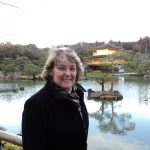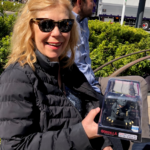Chile’s Atacama Desert & Easter Island
Where does one go when many of life’s bucket list destinations have been visited? For me, it was an invitation from Latam Airlines to see Chile‘s Atacama Desert and Easter Island.
Our group met and began our journey at Los Angeles Airport’s International Terminal in the Oneworld VIP lounge, before our afternoon departure to Santiago on Lantam’s new B787-900 Dreamliner.
After our morning arrival, we boarded a connecting flight to Calama, Chile. From there we had a 90-minute van transfer to our beautiful hotel, Alto Atacama Desert Lodge & Spa.
Located in the lush Catarpe Valley of the Salt Mountain Range, just over a mile from the plaza of San Pedro, Alto Atacama’s design was influenced by local village architecture and conceived to blend seamlessly into its environment and appear as a part of the terracotta colored ridge that rises behind it.
The setting, the sweeping views, the tranquility and silence make Alto Atacama a destination unto itself.
Environmental sustainability and a strong connection with the local culture have put Alto Atacama in a category of its own, as has its “Andescape” concept of decorative flora and stable of friendly llamas and alpacas, local cuisine and well educated guides.
After making a brief visit to our rooms, we enjoyed a leisurely late lunch on the patio of the hotel and then piled into our van to travel about 90 minutes to the Salt Flats of Aguas Calientes.
For about an hour we walked along paths in the vast salt beds and took photos of the flamingos that gather here and enjoyed the scenic reflections of the surrounding Andes mountains on the salt mirror.
We made our way to the van at sunset for refreshments and photos of the setting sun over the salt flats. Then it was back to the hotel for dinner and a good night’s rest.
The next morning I elected to acclimate to the high desert altitude (about 7,900 feet above sea level) and enjoy an included spa treatment offered by Alto Atacama’s Puri spa.
This was a 30 minute full body massage performed by local indigenous women in the spa, followed by a visit to a small outdoor pool filled with warm water from a natural hot spring called an Inca Bath…quite relaxing.
After lunch, we traveled by van to Rainbow Valley, so called due to the multicolored nature of it’s hills and cliffs, caused by the build up of different mineral deposits and their reflection in the sunlight. We enjoyed a long hike here.
Along the way we saw many llamas, alpacas and wild burros. That evening after dinner, several of us decided to go stargazing.
To give travelers the chance to get a “layman’s view” of the extraordinary blanket of stars visible from the Atacama Desert, Alto Atacama has its own observatory platform with a telescope located at an outstanding vantage point atop a small hill next to the lodge…Amazing!
On our last morning in the high desert, we were up at five am and out the door to go an even higher destination, Tatio Geysers, 14,176 feet above sea level.
Beginning at dawn we explored this geothermal field which consists of large pools of boiling water and mud, fumaroles, and natural hot springs. In the freezing sunrise, we enjoyed our buffet breakfast provided van side by our driver and guide. On our return we stopped at Machuca, a traditional village previously used by Andean shepherds.
We said our farewell reluctantly to the wonderful staff at Alto Atacama after lunch and headed back to the Calama Airport for our 8:39pm flight to Santiago where we arrived at 10:45pm.
We stayed overnight at the excellent Holiday Inn Santiago Airport, and met the next morning at 5am in the lobby for our 6:35am departure on the next leg of our adventure to Easter Island.
A territory of Chile located at the far eastern point of Polynesia in the middle of the Pacific Ocean, Rapa Nui, known as Easter Island by most tourists, is a place that has long been shrouded in mystery.
For decades the allure of this isolated volcanic island has been attracting visitors curious to discover the stunning scenery and the iconic statues, officially known as moai ( pronounced mo-eye).
There are more than 900 of these impressive stone statues, some as tall as 35 feet, that decorate most of the coastline. The legend has it that each moai represents an ancestor of one of the island’s twelve tribes, so each statue was named after an ancient chief.
After our late morning arrival in Rapa Nui, we were transferred the short distance from the airport to our hotel, the luxurious Hangaroa Eco Village & Spa.
A warm greeting and introduction to the hotel and its inclusive program was followed by staff escorting us to our rooms.
My room was an enormous and lovely Maunga Suite with an ocean and pool view. Separate bathrooms, wardrobes, sitting areas and patios gave me more room than I could ever need and I loved it!
We met in the late afternoon for a transfer to Tahai, which is in town right next to our hotel, to enjoy the sunset with the moai there.
That night we enjoyed dinner at one of the hotel’s fine restaurants. The hotel had three dining areas, with breakfast served buffet style in the main dining room. During our stay we ate at all of them.
The food was quite good, with an emphasis on seafood (great octopus and tuna) and Chilean-style food.
I really miss the mashed avocado dish offered for toast every morning at breakfast.
Our three days in Rapa Nui were filled with included tours to various sights to experience the history and culture of the island.
Some of my favorites were Anakena Beach, where eight moai stand tall guarding the lovely beach where the first Polynesian arrivals are thought to have landed.
I enjoyed the visit to the Quarry at Rano Raraku. Located on the edge of the Terevaka volcano on the north end of the island, Rano Raraku is where all the moai were hand carved from the volcano to be transported to their final destination. As this was the quarry, you can find moai in all stages of construction abandoned on the side of the hill.
To see them scattered around is a sight that will never be forgotten. Also of interest was Orongo. HIgh up on the side of Rano Kau, the largest volcano in Rapa Nui, is the historic Orongo Village. Here you find more than 50 stone dwellings looking out over the sea and towards a couple of small, rocky islands. This is where the ancient Birdman competition was held.
This contest would pit representatives from each of the 12 villages on the island against each other in a dangerous climbing and swimming challenge to get the first bird egg of the season laid on the island. The winner’s successful retrieval would give his village political power in Rapa Nui that year.
We also enjoyed the local show and dancers of Kari Kari who performed in the Village.
We left Rapa Nui on an afternoon flight on Latam 842 arriving in Santiago at 9:55pm and were transferred to the Lovely Singular Hotel in downtown Santiago.
Afer breakfast at the hotel we checked out with our luggage and boarded a van for our day tour of the renowned Santa Rita Winery. This was a day well-spent and included a cellar tour, a wine tasting, lunch at Dona Paula Restaurant, a visit to the Andean Museum, carriage tour of the estate grounds and a hotel inspection or the Estate’s hotel.
Our trip ended in Santiago Airport after check in with admission to Lantam’s new VIP lounge.
Then we boarded LA602 for our flight back to LAX after experiencing some of the world’s most remote, mysterious and interesting places.
Related Entries
Top Ten Travel Destinations in 2019
As the year and its holidays march forward, have you stopped to think: where should I go on my next...
Experiencing Patagonia’s Beauty
My Patagonia trip began in cosmopolitan Buenos Aires, Argentina and ended in the bustling city of Santiago, Chile. Along the...
Mysteries of Easter Island
Easter Island was given it’s name by the Dutch, who were the first Europeans to land here on Easter Day...



